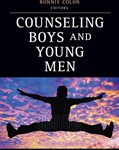 The first section of the book, Understanding and Promoting Healthy Development, focuses on the developmental issues affecting males from birth to adulthood. Although the authors briefly mention females in the section, males and their distinctiveness are further explored and explained. Males tend to benefit from therapeutic modalities catered towards action and activity. Furthermore, creating a supportive therapeutic milieu and avoiding interventions detrimental to the client’s progress, is integral. As part of the focus on developmental issues, the book discusses the intellectual range within the male population, from the gifted to persons with learning disabilities. Indubitably, understanding the nuances of the male species provides a greater opportunity to encourage boys and young men towards therapeutic goals.
The first section of the book, Understanding and Promoting Healthy Development, focuses on the developmental issues affecting males from birth to adulthood. Although the authors briefly mention females in the section, males and their distinctiveness are further explored and explained. Males tend to benefit from therapeutic modalities catered towards action and activity. Furthermore, creating a supportive therapeutic milieu and avoiding interventions detrimental to the client’s progress, is integral. As part of the focus on developmental issues, the book discusses the intellectual range within the male population, from the gifted to persons with learning disabilities. Indubitably, understanding the nuances of the male species provides a greater opportunity to encourage boys and young men towards therapeutic goals.
Seemingly, dyadic relationships are significant in the development of young men. Relationship Development and Relationship Concerns, the second section of the book, examines the complexities of young males’ interpersonal relationships. Family dynamics, romantic involvement, and sexual identity are the topics discussed in the aforementioned section. Accordingly, the authors elucidate the varying degrees of relationship issues and provide practical techniques for assisting males with these issues.
Emotional and Mental Health Concerns and Behavior Disorders and Concerns, the final sections of the text, outline the pervasiveness of mental health issues and the affects of conduct related behavioral disorders among young males. Presumably, young men tend to be commonly diagnosed with inattentive and conduct related disorders. Despite the apparent ubiquitous nature of specific disorders affecting young males, the authors assert specific treatment modalities may alleviate the therapeutic process. Moreover, environmental aspects of an individual’s life are certainly contributory factors to potential disorders. Thus, exploring ancillary aspects of young males’ lives is imperative in examining potential treatment avenues.
Counseling Boys and Young Men provides a plethora of information and counseling techniques essential to the continued development of young men. The counseling nomenclature is accurate and serves as a point of reference for novice and experienced counselors alike. The book offers a chapter on adolescent diversity; however, multicultural issues and the significance of distinctiveness could be further explored. The text serves as a noteworthy manual addressing the myriad of issues affecting young males in today’s society.
Degges-White, S., & Colon, B. (2012). Counseling Boys and Young Men. New York, NY: Springer Publishing Company.
Reviewed by: Jadarius Jackson, graduate student, North Carolina A&T State University, Greensboro, North Carolina.
The Professional Counselor Journal
